The Sorrow of Insanity : Mistreatment of the Mentally Ill : A Well Thought Out Scream by James Riordan

Recently, I have been doing research concerning the history of mental health treatment for a project I’m writing. Did you know that in the late 1800s, it was common practice to open the mental asylums in England to the public so the patients could be observed like animals in the zoo? Many patients were continually restrained in those days, even chained to the walls. It was the Quakers who so protested this public viewing that a law was passed forbidding it. By then however, the practice had become so popular that walls and iron gates had to be erected, not to keep the mentally disturbed in. but to keep the thrill seeking public out. In the early days of mental health treatment the supposed “cures” were often worse than the disease. Electroshock therapy and lobotomies became the rage. Walter Freeman, a neurosurgeon, toured America’s asylums demonstrating his simple lobotomy method which involved hammering an ice pick-like instrument into a patient’s brain through their eye sockets. The horrifying procedure often left patients in a vegetative state and is responsible for an estimated 490 deaths. Freeman is said to have performed 3, 500 lobotomies. Other treatments for mental patients included insulin-coma therapy, extreme cold and extreme heat treatments and things like the spinning chair and drowning therapy, all of which were said to have worked to a degree. The idea was to break the cycle of schizophrenia by shocking the system. Psychiatrists then believed that schizophrenics were trapped in a mental loop and that disrupting that loop was the only hope of recovery.
Unfortunately, the advance of the medicine and technology has not universally resulted in better treatment of the mentally disturbed. Take a drive through any medium to large city and you will see mental patients walking the streets. Some of them are on medication and in some sort of outpatient treatment program, but many of them are not. How did this happen? Well, many of the psychiatrists who were policy makers back in the 1950’s and 1960’s believe that this neglect was the result of an overrelia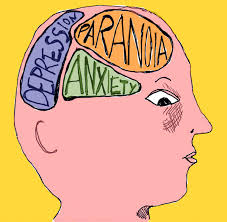 nce on drugs to do the work of society. Politicians at the time realized that mental health was creating huge financial problems for the government and they were desperate for a quick fix. The decisions that led to the release of most of the nation’s mentally ill patients from the hospital to the community is now widely regarded as a major failure. Recent reports of the American Psychiatric Association have pretty much spread the blame everywhere, faulting politicians, civil libertarian lawyers and psychiatrists. In many cases, cost-conscious policy makers were quick to buy optimistic projections that were, in many cases were backed up by misinformation and by a willingness to suspend skepticism. In California, for example, the number of patients in state mental hospitals reached a peak of 37,500 in 1959 when Edmund G. Brown was Governor and fell to 22,000 when Ronald Reagan took over the office in 1967, and continued to decline under his administration and that of his successor, Edmund G. Brown Jr. Dr. Robert H. Felix, who was then director of the National Institute of Mental Health and a major factor in the release of these patients says now: ”Many of those patients who left the state hospitals never should have done so. We psychiatrists saw too much of the old snake pit, saw too many people who shouldn’t have been there and we overreacted. The result is not what we intended, and perhaps we didn’t ask the questions that should have been asked when developing a new concept, but psychiatrists are human, too, and we tried our damnedest.”
nce on drugs to do the work of society. Politicians at the time realized that mental health was creating huge financial problems for the government and they were desperate for a quick fix. The decisions that led to the release of most of the nation’s mentally ill patients from the hospital to the community is now widely regarded as a major failure. Recent reports of the American Psychiatric Association have pretty much spread the blame everywhere, faulting politicians, civil libertarian lawyers and psychiatrists. In many cases, cost-conscious policy makers were quick to buy optimistic projections that were, in many cases were backed up by misinformation and by a willingness to suspend skepticism. In California, for example, the number of patients in state mental hospitals reached a peak of 37,500 in 1959 when Edmund G. Brown was Governor and fell to 22,000 when Ronald Reagan took over the office in 1967, and continued to decline under his administration and that of his successor, Edmund G. Brown Jr. Dr. Robert H. Felix, who was then director of the National Institute of Mental Health and a major factor in the release of these patients says now: ”Many of those patients who left the state hospitals never should have done so. We psychiatrists saw too much of the old snake pit, saw too many people who shouldn’t have been there and we overreacted. The result is not what we intended, and perhaps we didn’t ask the questions that should have been asked when developing a new concept, but psychiatrists are human, too, and we tried our damnedest.”
Originally, the policy changes were backed by scores of national professional and philanthropic organizations and several hundred people prominent in medicine, academia and politics. The belief then was widespread that the same scientific researchers who had conjured up antibiotics and vaccines during the outburst of medical discovery in the 50’s and 60’s had also developed penicillins to cure psychoses and thus revolutionize the treatment of the mentally ill.
The Joint Commission on Mental Illness and Health was one of the most influential groups in bringing about the new national policy. They were an independent body set up by Congress in 1955. One of its two surviving members, Dr. M. Brewster Smith, a University of California psychologist who served as vice president, said the commission took the direction it did because of ”the sort of overselling that happens in almost every interchange between science and government. Extravagant claims were made for the benefits of shifting from state hospitals to community clinics,” Dr. Smith said. ”The professional community made mistakes and was overly optimistic, but the political community wanted to save money.”
Psychiatrist and Federal official Dr. Bertram S. Brown was instrumental in shaping the community center legislation in 1963, agreed that Presiden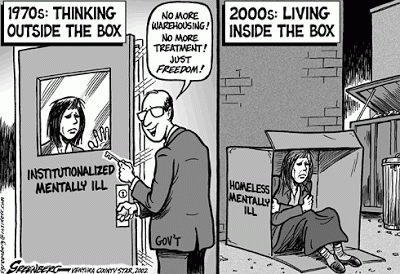 ts Eisenhower, Kennedy and Johnson were to some extent misled by the mental health community and Government bureaucrats. ”The bureaucrat-psychiatrists realized that there was political and financial overpromise,” he said. Dr. Brown, then an executive of the National Institute of Mental Health and now president of Hahnemann University in Philadelphia, stated candidly in an interview: ”Yes, the doctors were overpromising for the politicians. The doctors did not believe that community care would cure schizophrenia, and we did allow ourselves to be somewhat misrepresented. They ended up with everything but the kitchen sink without the issue of long-term funding being settled,” he said. ”That was the overpromising.”
ts Eisenhower, Kennedy and Johnson were to some extent misled by the mental health community and Government bureaucrats. ”The bureaucrat-psychiatrists realized that there was political and financial overpromise,” he said. Dr. Brown, then an executive of the National Institute of Mental Health and now president of Hahnemann University in Philadelphia, stated candidly in an interview: ”Yes, the doctors were overpromising for the politicians. The doctors did not believe that community care would cure schizophrenia, and we did allow ourselves to be somewhat misrepresented. They ended up with everything but the kitchen sink without the issue of long-term funding being settled,” he said. ”That was the overpromising.”
Dr. Brown said he and the other architects of the community centers legislation believed that while there was a risk of homelessness, that it would not happen if Federal, state, local and private financial support ”was sufficient” to do the job. The flat out truth is that there were not near enough resources to do the job. Dr. Brown still insists, as do others who were involved in the Congressional legislation to establish community mental health centers, that politicians and health experts were carrying out a public mandate to abolish the abominable conditions of insane asylums. He and others note – and their critics do not disagree – that their motives were not venal and that they were acting humanely.
Ii now seems clear that questions were not asked that might have been asked. In the thousands of pages of testimony before Congressional committees in the late 1950’s and early 1960’s, little doubt was expressed about the wisdom of deinstitutionalization. So today the two largest institutions that house the mentally ill are the Cook County and Los Angeles County jails. Mentally ill people often wind up living on the street and committing crimes just to survive.
The release of thousands of mental patients was taken because so many of the asylums housing them were corrupt and thought to be virtually unfixable, but fixing them is what was needed.
The Mississippi Lunatic Asylum
The history of mental health is appalling. There’s an old saying about finding out the real truth when you learn where the bodies are buried. Well, in 2013 the University of Mississippi discovered sixty-six coffins while constructing a road on the 164-acre campus. The bodies were believed to be former patients of the state’s first mental institution, called the Insane Asylum, built in 1855. When the university began work in 2014 on a parking garage east of the dental school, underground radar revealed 1,000 coffins. More radar work revealed more coffins and today it is believed that up to 7,000 bodies are buried across twenty acres of the campus. They are all former patients of the state’s first mental institution, called the Insane Asylum, built in 1855. There is no record of why or how they died. Like many of mental health patients, they were just put away.
University of Mississippi Medical Center officials first began to discover the scores of unmarked graves on campus in 2013 while building a road (pictured on the right)
Exhuming and reburying these bodies will cost about $3,000 each, as much as $21 million total. Now UMMC is studying the cheaper alternative of handling those exhumations in-house, at a cost of $400,000 a year for at least eight years. It also would create a memorial that would preserve the remains with a visitors center and a lab that could be used to study the remains as well as the remnants of clothing and coffins. The asylum was  Mississippi’s first mental institution and was constructed for $175,000 in 1855. Before then, those suffering from mental illness were chained in jails and even attics, said Luke Lampton, chairman of the state board of health. While the asylum provided a better place for patients, life remained harsh. Of the 1,376 patients admitted between 1855 and 1877, more than one in five died. After the Civil War, the facility expanded to house 300 patients, and the area became known as “Asylum Hill,” a neighborhood that included houses, a school and Cade Chapel Missionary Baptist Church, a church for former slaves.
Mississippi’s first mental institution and was constructed for $175,000 in 1855. Before then, those suffering from mental illness were chained in jails and even attics, said Luke Lampton, chairman of the state board of health. While the asylum provided a better place for patients, life remained harsh. Of the 1,376 patients admitted between 1855 and 1877, more than one in five died. After the Civil War, the facility expanded to house 300 patients, and the area became known as “Asylum Hill,” a neighborhood that included houses, a school and Cade Chapel Missionary Baptist Church, a church for former slaves.
Derek Anderson and Forrest Follet from the Cobb Institute of Archaeology remove dirt from the lid of one of the graves in 2013. The coffins are likely so compressed because of the weight of the soil
At its peak, about 6,000 patients stayed at the asylum, and the facility provided many jobs to the area. In 1935, Mississippi moved the asylum to the present location of the State Hospital at Whitfield. Karen Clark of Clinton, MI. says her great-great-great grandfather, Isham Earnest, is believed to have died at the Mississippi’s mental institution between 1857 and 1859 and she would like to see a grant given to collect DNA from all the patients. “It would make these people identifiable if family members came forth,” she said.
She is willing to donate her own DNA to see if it matches the War of 1812 veteran who moved to Neshoba County in 1842 and was ruled “insane” in the 1850s and is believed to have died at the asylum between 1857 and 1859. “Hundreds, if not thousands, of descendants are here today because of Isham Earnest,” she said. “Many are teachers, nurses, educators and ministers.”
In this 2013 UMMC photo, Forrest Follet from the Cobb Institute of Archaeology, Mississippi State University, removes the soil from the lids of the dozens of unmarked graves uncovered during construction on the…UMMC Campus.
When Clark recently went through old asylum records and read about patients there, she felt overcome with emotion, she said. “I thought, ‘This person could be saved if modern medicine were there.’ ” Her sympathy runs high for those in the asylum “because I’ve had mental issues in the distant past,” she said. “No one took me and dumped me.”
“It would be a unique resource for Mississippi,” Molly Zuckerman, an associate anthropology professor at the school, told The Clarion-Ledger. “It would make Mississippi a national center on historical records relating to health in the pre-modern period, particularly those being institutionalized.”
Unfortunately, there is a story like this in virtually every state. And it’s not getting any better.
___



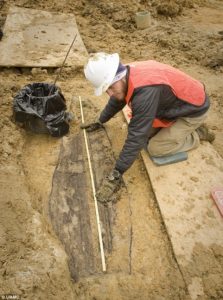
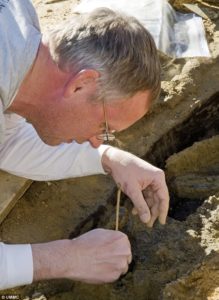
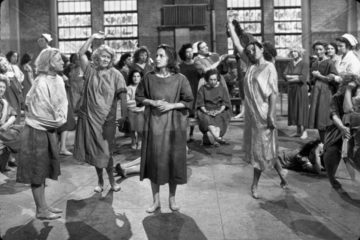


No Comment